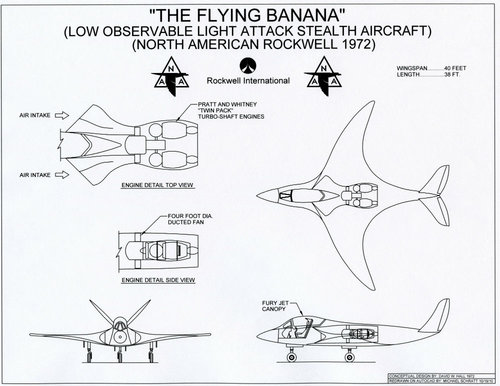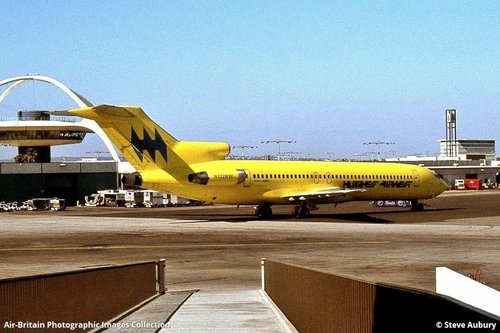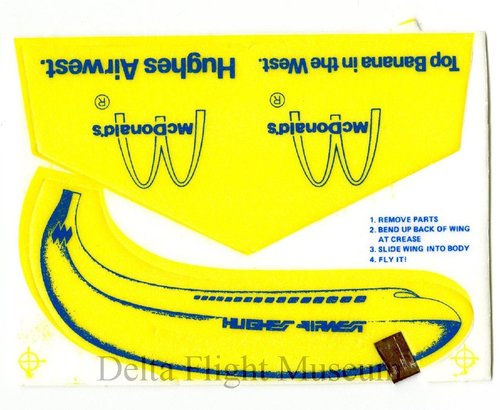You are using an out of date browser. It may not display this or other websites correctly.
You should upgrade or use an alternative browser.
You should upgrade or use an alternative browser.
NA/Rockwell 70's Stealth: Flying Banana, Silent Attack & Surprise Fighter
- Thread starter overscan (PaulMM)
- Start date
- Joined
- 26 May 2006
- Messages
- 34,928
- Reaction score
- 15,798
Attachments
- Joined
- 3 June 2011
- Messages
- 18,349
- Reaction score
- 12,269
A project I've never heard of until today, looking through the Rockwell bomber study PDF here:
http://stinet.dtic.mil/cgi-bin/GetTRDoc?AD=C016293&Location=U2&doc=GetTRDoc.pdf
Concept 4-1 uses stealth technologies developed under Rockwell's Surprise Fighter program. Radar tests of a model of this shape showed virtually no radar return from most directions. The aircraft penetrates at high mach number with its wings fully stowed, leaving only a slab-sided shape with minimal intersections.
Interesting that this knowledge didn't appear to make it into their ATF concept.
- Joined
- 19 July 2016
- Messages
- 4,287
- Reaction score
- 3,466
I'm sorry I must appologise, I have for a while been gettin my reading of the title wrong, lazyness perhaps. Instead of
"NA/Rockwell 70's Stealth: Flying Banana, Silent Attack & Surprise Fighter", I have seen part to read as "Silent Banana". Sorry folks, my bad...........
IMHO though, my version works much better as a defence program title.
"NA/Rockwell 70's Stealth: Flying Banana, Silent Attack & Surprise Fighter", I have seen part to read as "Silent Banana". Sorry folks, my bad...........
IMHO though, my version works much better as a defence program title.
- Joined
- 3 June 2011
- Messages
- 18,349
- Reaction score
- 12,269
Scott Kenny
ACCESS: USAP
- Joined
- 15 May 2023
- Messages
- 11,676
- Reaction score
- 14,398
The "Flying Banana" looks like a scaled up version of an early stealth drone (The pictures represent early attempts at designing stealth attack aircraft in the early seventies. The mission was to attack an SA-2 site.
The "Flying banana" and the "silent attack aircraft" are from North american, the surprise fighter is from Rockwell.
All vehicle incorporated FLIR and some sort of plug in the exhaust to prevent line of sight to the hot section. The surprise fighter was interesting in having pivoted wings which disappeared under the fuselage. I can only assume that penetration would occur at low altitude and high speed, and body lift was all that was needed. There is at least another later Rockwell bomber that relied on this concept, although in that case the design had a one piece oblique-wing hinged at the center as opposed to two variable geometry semi-wings. weapon launch in the Rockwell fighter was through a system similar to torpedo tubes. Exhaust doors at the back would open at the time of launch.
Last edited:
Awesome. So - that's where Tom Clancy got that idea of a surprise attack by a surprise fighter, to kill those pesky Soviet AWACS ? I note that (dreamland) frisbees are close from bananas, in shape [hell, crap - boomerangs, not frisbees - silly me, forget that)
How about that ?
I readily agree the non-banana surprise fighter certainly looks like a revamped YF-107 for stealth.
That forum is full of surprises.
How about that ?
I readily agree the non-banana surprise fighter certainly looks like a revamped YF-107 for stealth.
That forum is full of surprises.
Last edited:
OPERATION DREAMLAND
Frisbees of dreamland
- Joined
- 19 September 2023
- Messages
- 14
- Reaction score
- 9
Yes!
- Joined
- 6 August 2007
- Messages
- 3,898
- Reaction score
- 6,000
Interesting that this knowledge didn't appear to make it into their ATF concept.
In 1972 or 1973 Lt Col Delbert Jabcobs authored the "Surprise Attack Technology Prototype" paper. In it he describes what is almost certainly the "Surprise Fighter"
Stevenson, in "The $5 Billion Misunderstanding" quotes portions of the paper:
Myers said air force Lt. Col. Del Jacobs was also advocating a "surprise fighter" that was shaped like a wedge. Jacobs advocated his surprise fighter concept in spite of the reception that tended "to create controversy and outright opposition in some cases." In a paper Jacobs circulated entitled "Surprise Attack Technology Prototype," he stated that surprise gave a fighter an 800 percent advantage over an airplane that had been noticed.
The overwhelming value of surprise attack has been largely over- looked in favor of powerful airborne search radars, costly weapon systems optimized for agility against a violently maneuvering foe, and the resultant large, expensive, high-performance fighter aircraft capable of performing the all-threat, all-aspect, all-weather air supe- riority task... . We need to complement this all-weather, all-threat fighter force with an astute balance of less costly fighters, optimized to achieve surprise in day or night good weather air combat.
Jacobs advocated the use of technology to minimize radar reflection and emissions. He also wanted to be able to track the enemy's "particular chemical exhaust signature .. . along with persistent atmospheric turbulence due to wing tip vortex phenomena. Some, or a combination of these radar, IR, acoustic, chemical, and other energy emissions provide the basis for a passive detection, acquisition, and tracking system."
Perhaps the most significant proposal Jacobs made was his advocacy for a radar-homing air-to-air missile, which would have changed the calculus of air-to-air combat. "Radar homing missile capability can exploit ... and .. . discourage enemy use of air-to-air search radar just the way Shrike and other anti-radiation missiles have limited SAM search radar operations."
For night operations, Jacobs wanted to rely on reduced radar sig- natures. For daylight missions, he said, "visual detection avoidance and optical tracking degradation methods include: (1) adaptively controlled lights to reduce contrast; (2) optical deception (using corner cubes, holography, flashing lights, etc.); (3) improved camouflage paint; and (4) smokeless engines."
I am uncertain in what capacity Jacobs authored the paper, and wether it was a proposal or a description of an existing program. He later worked for the F-16 and F-15 SPOs, and in 1979 made Brigadier General. In 1983 he retired from the Air Force and took as position at Northrop as the program manager for their ATF proposal.
I have so far been unable to locate a copy of the "Surprise Attack Technology Prototype" paper. Based on the above though it does seem that the "Surprise Fighter" had at least some air to air role.
It also appears that the "Silent Attack" paper may have triggered other reduced observable efforts, including the USAF visual signature reduction / optical countermeasures efforts of the early 1970s. It also, clearly, served as the inspiration for Myer's "Harvey" concept (which was a dead end).
The "Silent Attack" design was almost certainly a Navy program. At the time of the "Silent Attack" study the Navy ONR was conducting similar studies with other contractors (McDD, Boeing, Lockheed). The McDD "Quiet Attack Aircraft" was one of those studies.
Similar threads
-
Rockwell International flying boat studies late 1970s
- Started by Triton
- Replies: 7
-
Rockwell NR-356 Sea Control Ship (SCS) V/STOL fighter (XFV-12A)
- Started by KnightTemplar
- Replies: 174
-
Flight Dynamics Laboratory BQM-106 "Teleplane"
- Started by Stargazer
- Replies: 7



